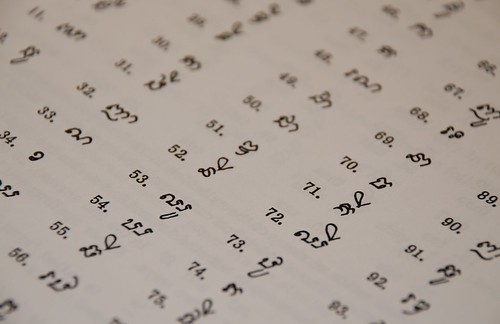This is Part I of a three-part series on developing tests for reading skills in non-major languages. Stay tuned for Part II: Fluency and Comprehension and Part III: Assessment Start to Finish.
Teaching students to read is hard enough when you’re working in a major world language. For many of us, the languages we teach in are spoken by only a few million people, or even as little as a few hundred. Assuming that texts exist in these contexts (and they often do), how can we take what we’ve learned from English language reading and use it to design assessment tools for other languages with little to no resources?
Fortunately, the basics of literacy development hold true across languages and alphabets. While we can’t have one assessment that works universally, we can identify basic rules that make it possible to design reading assessments for any context.
Reading literacy can basically be broken down into three aspects: Decoding, Fluency, and Comprehension. This series will give you the foundations you’ll need to design reading tests for students in any language, as long as you can read and write that language with some fluency.
Defining Decoding
Decoding, at its most basic level, is the ability to translate the characters in written words into the sounds they represent. It requires knowledge not only of the sound each character makes, but also of the changes and combinations that occur as letters are placed next to one another.
Young readers follow a surprisingly consistent pattern when learning to decode. If you want to get elbow deep in how this pattern works in English, I highly suggest the book Words Their Way, which is a masterpiece on the process of decoding (although the latest edition appears to be getting some criticism on usability). Luckily for us, it’s possible to apply the findings in this book to readers of other languages without duplicating decades of research, at least through the early stages of development.
For a simplified approach, we can break decoding down into three major stages that will allow you to test basic reading skills at an early age. With a bit more work, you can further break down the final stage to put more advanced readers along a continuum of proficiency.
1. Basic Consonants (Pre-Reader)
Essentially, the first thing early readers are able to pick out are simple, singular consonant sounds, especially those at the beginning and end of a word. Rather than reading and writing whole words, they simply sound out or write the first and last consonants of each word or syllable. In some languages, these consonants may not actually come “first” when written, but the focus here is on whether or not the student can pick out the first and last consonant sound in a simple word.

2. Basic Consonants and Vowels (Basic Reader)
Once students can pick out the “buhs”, “mms,” and “kuhs” of a text, they then start to add vowels into the mix. “buh…duh” becomes “bad,” “cuh…tuh” becomes “cat” and so on.
3. Complex Vowel and Consonant Construction (Reader: Early, Intermediate, Advanced)
At this stage, we’re seeing true mastery of reading, and students are likely able to work their way through sentences and basic texts. Students can sound out and write words that contain more complex constructions such as digraphs, blends, and dipthongs. Depending on the language in question, it is possible to break this section down into many more levels to create tool that can accurately measure advanced readers along a spectrum.
However, because languages are so different, it’s hard to produce an easy guide to this. The goal is to identify those difficult features that early readers and writers learn progressively. Some examples of these features in English, in order of their difficulty:
Digraphs such as “sh” and “ch“
Blends such as “dr” and “pl“
Complex Vowels and Dipthongs such as (in order of difficulty) “a-e” as in “make,” “oa” as in “boat,” “ew” as in “chew,” “oi” as in “foil,” or “ar” as in “part“
Tones?
Tonal rules don’t exist in English, and therefore we have fewer precedents of where they fall on the difficulty spectrum. In most tonal languages, tone marks and rules probably fall somewhere in-line with the complex vowels. In some, they may be inextricably tied together.
A great way to further break down this section would be to make the assessment intuitively using the English features as guideposts (more on that below), and then, rearrange the words as necessary after completing some initial tests to accurately determine the progression of difficulty. Once you have the order of features determined, you can then identify reader subgroups such as early, intermediate, and advanced.
A Note: Peculiarities of language
English is rife with exceptions and peculiarities. The final step for learning to read English is to memorize borrowed/loan words, root words, and the like that extend beyond the established rules. Some languages with phonetic alphabets may lack this category of exceptions entirely, while others may have such an informal writing system that this makes up the lion’s share of words in that language. For the sake of simplicity, we’ll leave this section out of the testing examples as it can change so dramatically from language to language.
Testing Decoding
Decoding can be tested quickly and easily with a basic spelling test. Generally, if a student can spell a word, that means they have the decoding skills necessary to sound it out as a reader. The idea is to design a spelling test with words that get progressively more difficult. If you’ve done this properly, you should be able to see a clear point after which a student starts making mistakes. That point indicates their skill at decoding. There may be a few anomalies (students can memorize the spelling of certain words without understanding the rules that govern them), but in general, the cut-off point should be relatively obvious.
An example of a short assessment in English might be:
- put
- can
- fun
- win
- rope
- gain
- coat
- whine
- fight
- spoil
- shipping
- chewed
- march
- swerving
- flavor
- measure
- immortalize
This test can be given quickly and easily to an entire class in a matter of minutes and gives you at least a basic indicator of your students’ decoding ability. In this example, a pre-reader would only be able to write the first and last consonant of many of the early words. A basic reader would probably get the first four correct, and then make logical errors for the remainder of the test: “when” becomes “wen,” “coat” becomes “cot,” etc. A reader would get variably further, depending on his or her skill. If you’ve designed the progression well, you should be able to clump readers further into groups such as early, intermediate, and advanced, although the exact signifiers for those groupings will differ depending on the language in question.
The more words in the test, the more accurately it will indicate a student’s level. I highly recommend doing some test runs at first to see if your intuitions about the more complicated structures in the language (English examples being blends, digraphs, and complex vowels) are correct.
Creative Commons Love: AbishekSundiram, Ninha Morandi, Neve*Sottile, and Lorna87 on Flickr.com


















